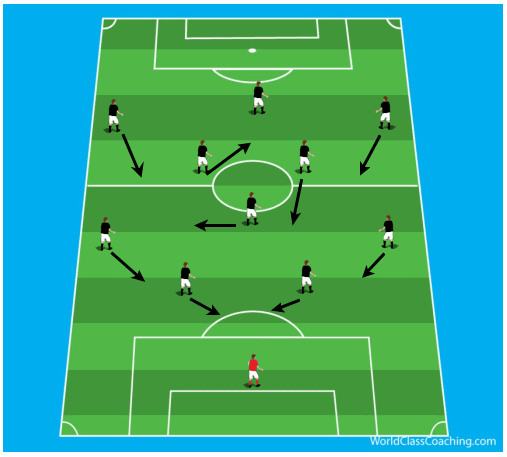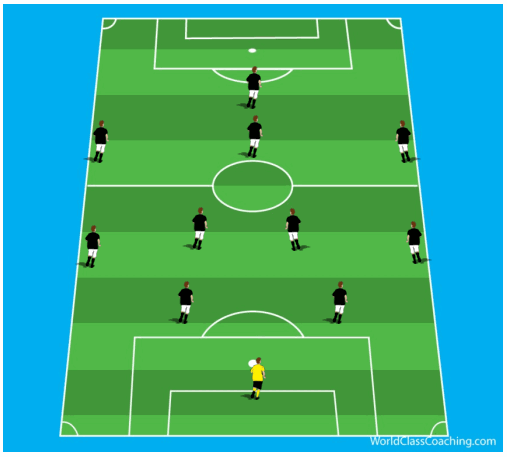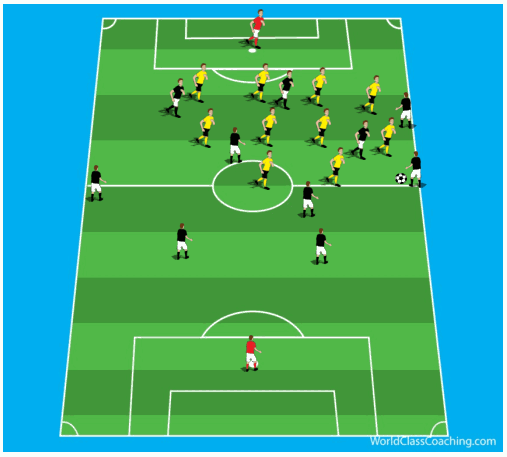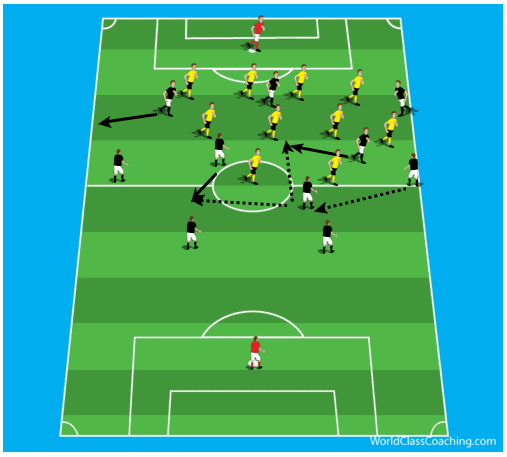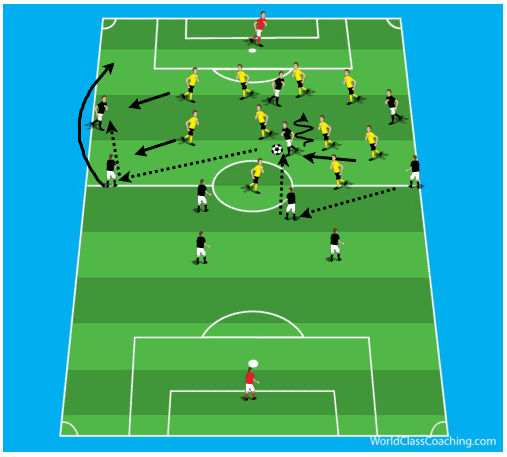This is a short excerpt from Coaching the 4-2-3-1 Advanced Tactics by Stevie Grieve. The book takes a detailed look at how to get the best out of this very popular formation.
When changing formation, there are many variables that can come from this, mainly from an attacking and defensive positioning starting position basis.
Some players’ roles and responsibilities change, although not drastically. In a 4-3-3 and 4-2-3-1 some players responsibilities stay the same, mainly the back 4 and central striker. The back 4 as always must protect the goal and defend as a priority, then support the attacking phase secondary.
Full backs in very attacking teams can allow wingers to play slightly more infield if they wish, or if the winger stays on the touchline, provide deep support or an under lapping run to offer an extra option if places under pressure. The runs from the full back can open up new solutions when the ball is with the winger.
Some wingers can commonly play 1v2, so the attacking full back can make it a 2v2 on the side, and this can also provide a 2nd outball to the sides from the centre. Full backs in more defensive teams may tend to stay behind the line of play to be closer to the defence and enable a swift transition and re-shape into defensive positions.
The striker, in both formations, plays alone against generally 2 central defenders, and so this player must look to offer an outball into feet to hold play up, or to draw a defender out of position, but also have the intelligence to know when to move into the channels to offer a pass behind the defence, or move to create space for other players.
Changing a 4-3-3 Into a 4-2-3-1
Moving from the 4-3-3 into a 4-2-3-1, the wingers drop deeper, around 8-12 yards and play between the midfield line and centre forward, while one of the 2 central midfielders moves forward around 8-12 yards to become the attacking midfielder, playing in a line with the wingers, and behind the striker.
The other central midfielder will drop 8 yards deeper to play in line with the defensive midfielder and these players will cover the space behind the 3 attacking midfielders and infront of the defence. These players look to provide the correct distances between the lines and control the space infront of the defence – too much space left and a clever attacking midfielder will exploit it, and too deep allows the opposition to gain control of the centre of the field.
In a 4-3-3, the advantages of moving from a 4-3-3 into a 4-2-3-1, is that when before there was 1 holding central midfielder, acting as a midfield ‘sweeper’ for any play breaking down or offering a pass back to retain possession, in a 4-2-3-1, there is now 2 players doing this role, which can be designated as a right side DM and a left side DM so for example, if the holding midfielder is a slow player, that player may need help covering the space between the width of the field between the midfield and defensive lines.
This may help if the 4-3-3 isn’t keeping possession close to the opposition goal, and when play breaks down, the 4-3-3 may be more open to counter attacks than a 4-2-3-1. Having 5 players attacking in the 4-3-3 (2 central midfielders and 3 attackers), means that there will be a back 4 and one player protecting the defence in a counter attacking scenario. In the 4-2-3-1, the central midfielders know that when one presses the ball, there will be cover inside protecting the defence.
Players’ new starting positions when moving into a 4-2-3-1 from 4-3-3
Now that the formation has become 4-2-3-1, the main change is that the triangle has rotated from a 1-2 triangle with lots of space between midfield and centre forward for players to move in and out of, to a 2-1 triangle with a space between defensive midfield; the base of the triangle, and attacking midfield; the top of the triangle.
A team playing in a deep 4-4-2 may struggle against this formation as it allows two players to play infront of the midfield and offer a pass between the 4-4 defensive shape into the attacking midfielder who will now play between the lines.
4-4-2 Defensive shape v 4-3-3 with the ball at the right full back of the 4-3-3
Above, the right back has the ball, he has 3 options to pass forward but all have the possibility to lose possession due to defensive overloading. The best solution may be to pass inside and change formation.
- Option 1 – Pass into the right winger - The defending left midfielder will likely have closed off the passing lane to the winger. If the pass is successful, the winger is 1v1 against the left back. The far side winger and the striker will enter in the box early while the central midfielders should move forward to support from deep with late runs into the box.
- Option 2 – Pass into the right central midfielder between the 2 opponents. The defensive left central midfielder can quickly put pressure from behind and force play back. If the RCM can turn side-on and protect the ball, he can penetrate the line with a pass forward, possibly looking for a 1-2 with the striker or a pass into the striker to switch play to the far side.
- Option 3 – Pass into the centre forward. The central defender will play tight and place lots of pressure on the centre forward to hold play up well and protect the ball, to allow the 2 central midfielders to support from deep. The defence can intercept any misplaced passes into feet or a high pass could be played badly and force a turnover of possession easily.
4-3-3 changes to 4-2-3-1 as the pass is played inside to the bottom of the triangle
As the right full back passes to retain possession, there is a trigger to change formation between the right and left central midfielders – the left central midfielder drops deep and in-line with the defensive midfielder, while the right central midfielder makes a quick arced run into the space between the lines to receive between the 2 strikers pressing the ball, and if possible, infront of and between the central midfielders of the 4-4-2, preferably on the half turn, enabling a quick turn and penetration of the midfield line with a dribble or a pass into the striker.
Another option is to switch play to the far side. As this happens, the far side wingers will drop deep and wide in line with the RCM (now attacking midfield). If the ball can be switched from here to the left side, this can allow an overlapping run and possible 2v1 on the far side.
Attacking midfielder switches play to open up an attacking possibility on the far side
As the attacking midfielder (RCM in 4-3-3) has received side-on, and has blocked pressure from behind, he can see his team mates on the far side and the possibility of a 2v2 on the far side with a pass and overlap. From here, the striker, far side winger and attacking midfielder could all enter the box for a crossing possibility. The full back presses the winger and allows the full back space to receive the pass whilst overlapping, making the 2v1 on the side effective and allows a crossing scenario for the attack with numbers inside the box.
This is just a fraction of what Stevie has to offer in Coaching the 4-2-3-1 Advanced Tactics. Be sure to click the link if you'd like to learn more about the book and the 4-2-3-1 formation.
By Stevie Grieve. (Follow on Twitter @steviegrieve) Stevie is also the author Coaching the 4-2-3-1, Coaching the 4-2-3-1 Advanced Tactics and From Futsal to Soccer

